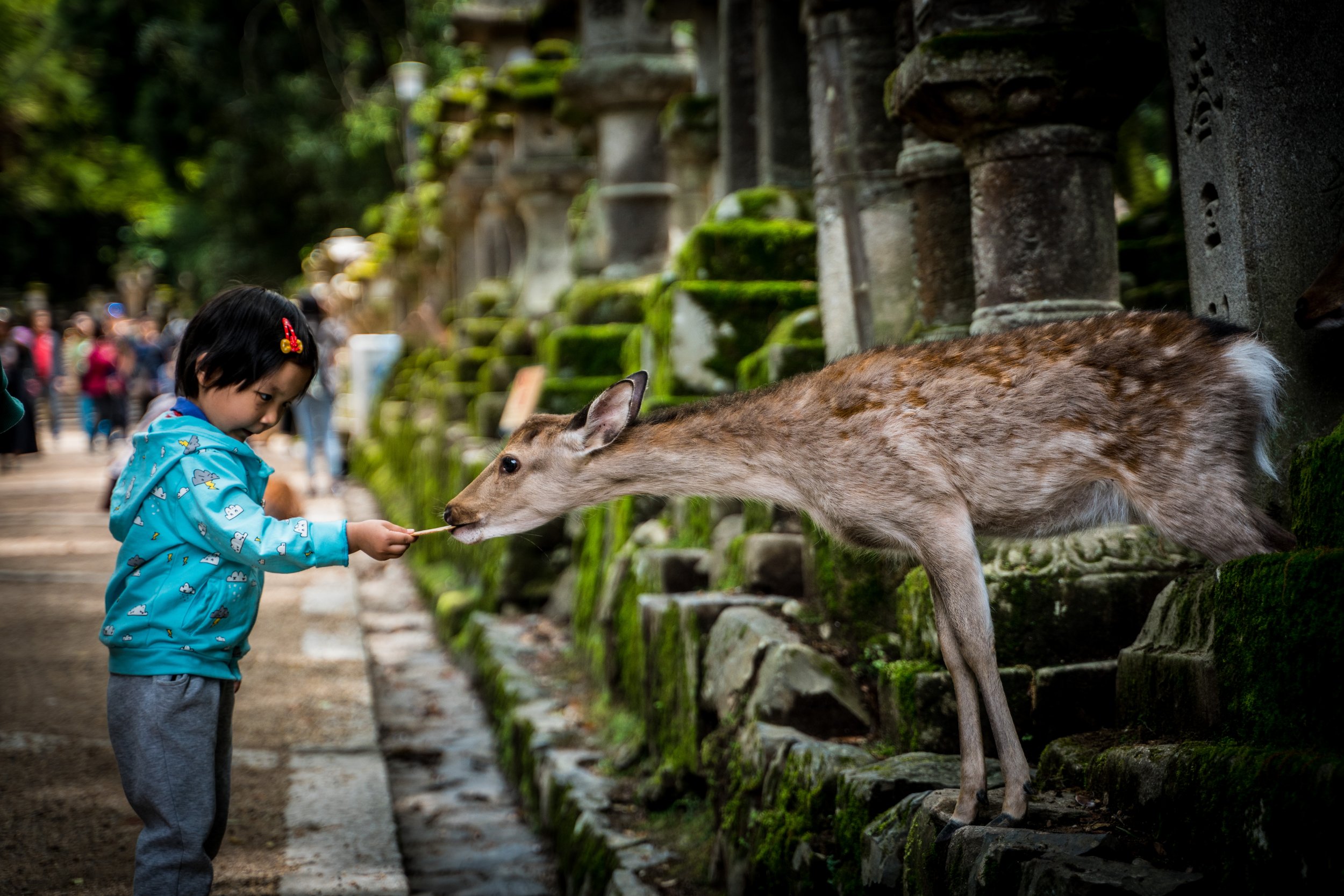Appreciating Nara Deer Park
by Laura Studarus
A guide to one of Japan’s most magical tourist attractions
Move through Japan like one of Miyazaki’s magical characters
Nara, Japan is home to 1,200 of the most famous deer in the world. Tourists flock to Nara Park to get up close and personal with some of the nation’s most ethereal animals, and even British rock band alt-J count themselves as fans, dedicating not one, not two, but three tracks of their 2014 album This is All Yours to the experience of visiting. If you count yourself as a cervidaephile, Instagram aficionado, or just want to experience a slice of the seemingly magical wilderness in the middle of a city—good news, planning a day trip to Nara is as easy as a (literal) walk in the park.
First, a bit of background
Nara Park was officially established in 1880 as a 14-hectare refuge for the area’s deer, once hunted into near-extinction. With good reason, the deer are considered to be a natural treasure, and sacred creations—thanks in part to the legend of enshrined deity Takemikazuchi-no-Mikoto, who is believed to have appeared on Mount Mikasa riding one of the local deer. Today, the protected space now stretches 660 hectares, which means there’s plenty to explore.
Getting there
Nara is an easy day trip from either Kyoto (35 km away) or Osaka (28 km). With both cities, you can get to Nara via the JR line (which means you can use your rail pass) or via the privately-owned Kintetsu Line. Express trains cost between ¥690-¥1100 (approximately $6 to $10 USD) and take about 45 minutes. Once you’re there, the park is only a 20-minute walk from Nara Station or six minutes from Kintetsu Nara Station. When in doubt, let the crowds be your guide, and keep an eye open for deer, who have a habit of appearing long before you reach the official park boundaries.
When should I visit?
The park is a public area without closing hours, so let your feet be your guide. So, short answer: visit anytime you’d like. However, keep in mind that deer tend to retreat into the forest later in the afternoon and evening, so for the ultimate photo op, aim for earlier in the day. If you’re feeling really ambitious, it’s worth entering the park before sunrise, simply to hear the early morning when a monk calls the deer down from the hills for the day at first light. (They really do respond!) In October, you can witness Shika-no-Tsunokiri, the ritual antler cutting event. Several times a year, there’s also a deer calling ceremony, where the animals are summoned via trumpet from deep in the forest. And springtime is fawning season!
Where to stay
Staying in either Kyoto or Osaka means you’ll get more of a variety of experiences on your trip, with limited travel times into Nara. However, if taking it slowly is more your preferred speed, there are plenty of places to stay in Nara. For the full experience, consider visiting a ryokan like Hotel New Wakasa, Kotonoyado Musashino, or Tsukihitei. These traditional Japanese inns offer outdoor baths, sleeping mats, and Japanese menus—making a deer-filled escape that much more memorable.
How much does it cost?
The best things in life are free—and that includes the Nara Deer Park. If you’d like to explore the onsite temples or points of interest, like Todaiji Museum, Hokkedo Hall, and Kaidanin Temple, each visit will cost ¥600 (about $5 USD).
Is it ethical?
In the Shinto religion, deer are considered holy—and today the animals are still considered to be living monuments. Up until the 1600s, killing one could end in capital punishment, and even now the offense carries harsh jail sentences and devastating fines. As a result, the park’s voluntary visitors are held in high esteem, very well-cared for, and are free to come and go at will. The only place you’ll see a fence is in the rehabilitation area, where injured or sick deer are given the space to get well without visitor interference.
What kind of interaction can I have with the deer?
Sure, you could pet the deer, but keep in mind no matter how much they might resemble Ghibli characters, they’re wild animals and can act unpredictably. Instead, try winning your new friends over with a packet of deer crackers, sold around the park for ¥200 per bundle. (Don’t feed them anything else!) Many of the deer have learned how to bow for a treat, so be sure to bow back, and reward them with a cracker for their efforts. If you’re surrounded and feel a bit overwhelmed by the attention, extricate yourself by moving away and waving “bye-bye” with both hands—believe it or not, most of your new buddies know sign language.
Anything else I should know about respecting the deer?
It’s worth saying again—even if they’re the stuff of animal lovers’ dreams, deer are still wild animals. There’s nothing to be scared of, but it’s worth being cautious! Feed them crackers, and only the ones you buy on site. Don’t tease them, it only encourages nipping. And be aware of does and their fawns; no mother likes when you stand between them and their offspring.
How much time will I spend in the park?
Since the deer come and go as they please, there’s no promise how many of the park’s residents you’ll encounter—or even if you’ll see any at all. (Don’t worry, this occurrence is rare!) Our advice? Lace up your walking shoes and take your time. Visitors usually spend an hour or two in deer mode, but there’s nothing to say you can’t break for a tea or lunch, and return for sunset or a photo shoot.
What’s the perfect souvenir?
Japan loves mascots, so naturally Nara has not one, but two reps. Sento-kun, the ambassador for the city, is a young boy with deer horns. Adorable, even though though his introduction in 2010 caused a stir when it was pointed out he looks a little too much like Buddha—leading many to call blasphemy. Meanwhile, Shikamaro-kun is a fuzzy, cartoonish, deer who works as the official mascot for the park itself. During your walk from the train station to the park, you can find both Sento-kun and Shikamaro in nearly every plush, magnet, cup, candy, and souvenir form your heart could possibly desire.





